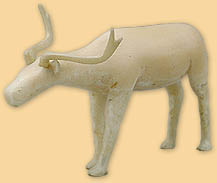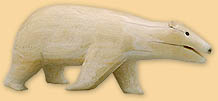 |
J. Dewey Soper was sent to Baffin Island in 1924 as naturalist/explorer
by the Geological Survey of Canada (GSC) to collect and study specimens
of the local fauna and flora. He travelled on the Nascopie and
arrived in the summer of 1924 at the RCMP detachment of Pangnirtung,
which he used as his headquarters. From there, he made several hazardous
journeys by boat and dogsled.
Early in 1926, he travelled to Cape Dorset where he stayed the
summer. While in Cape Dorset, he collected a series of ivory figures
which were delivered to the GSC as part of a large collection of
ethnographic artifacts. His memoirs do not make any reference to the
ivories or their maker(s).* They are the only examples of historic
ivories from Cape Dorset in the CMC collection.
J. Dewey Soper went on to become an ornithologist of national
distinction. With the help of local Inuit residents, he determined
the nesting grounds of the Canada Blue Goose. Several geographical
features on Baffin Island are named after him.
*J. Dewey Soper
1981 – Canadian Arctic Recollections: Baffin Island
1923-1931. Saskatoon: University of Saskatchewan – Institute for
Northern Studies.

 |
Caribou, 1926
Cape Dorset, Nunavut
Ivory
5.2 x 8 x 17 cm
CMC IV-C- 2681
Collected by J. Dewey Soper during his stay in Cape Dorset in
the summer of 1926
|
 |
Many beautiful sculptures of caribou have come out of Cape Dorset
over the past 50 years, especially those by Osuitok Ipeelee. This
demonstrates the continuation of an artistic tradition. We can easily
imagine this piece, executed on a larger scale and in stone, looking
very much like contemporary work from Cape Dorset.
Exhibition History:
Pangnirtung in the 1920s. The J. Dewey Soper collection.
Canadian Museum of Civilization, Gatineau, Quebec. Mall case,
January 2003 to present.
References:
Blodgett, Jean
1988 – "The Historic Period in Canadian Eskimo Art."
Page in Inuit Art: An Anthology. Winnipeg: Watson & Dyer,
ill. p. 24.
von Finckenstein, Maria
2003 – "Early Ivories from Cape Dorset." Inuit Art
Quarterly 18(4): ill. p. 20.
Bear, 1926
Cape Dorset, Nunavut
Ivory, black colouring
3 x 5 x 17 cm
CMC IV-C-2679
Collected by ornithologist J. Dewey Soper in Cape Dorset on Baffin
Island during the summer of 1926
|
 |
This bear is compact, and can be gripped in the hand, without the
legs breaking off. It is also highly stylized, in contrast to works
made for European traders which tend to have more realistic detail.
All these aspects point to this item having been a toy before it was
sold to Soper in exchange for tobacco or other barter items.
Exhibition History:
Pangnirtung in the 1920s. The J. Dewey Soper collection. Canadian
Museum of Civilization, Gatineau, Quebec. Mall case, January 2003
to present.
Reference:
von Finckenstein, Maria
2003 – "Early Ivories from Cape Dorset." Inuit Art
Quarterly (18)4: ill. p. 21.
 |
Bear, 1926
Cape Dorset, Nunavut
Ivory, black colouring
11.8 x 3 x 4.5 cm
CMC IV-C-2680
Collected by ornithologist J. Dewey Soper in Cape Dorset on Baffin
Island during the summer of 1926
|
 |
The bear is trotting eagerly forward with its mouth open in
anticipation of what may be ahead. With its endearing, almost human
expression, the sculpture is a forerunner of many bears to be produced
later in the twentieth century by Cape Dorset artists, notably Pauta
Saila with his dancing bears.
Exhibition History:
Pangnirtung in the 1920s. The J. Dewey Soper collection.
Canadian Museum of Civilization, Gatineau, Quebec. Mall case,
January 2003 to present.
References:
Blodgett, Jean
1988– "The Historic Period in Canadian Eskimo Art" in
Inuit Art: An Anthology. Winnipeg: Watson & Dwyer, ill. p. 22
von Finckenstein, Maria
2003 – "Early Ivories from Cape Dorset." Inuit Art
Quarterly 18(4): ill. p. 21.
Model of a Rifle, 1926
Cape Dorset, Nunavut
Ivory, black colouring
1.4 x 1.3 x 14.8 cm
CMC IV-C-2690
Collected by ornithologist J. Dewey Soper in Cape Dorset on Baffin
Island during the summer of 1926
|
 |
Illustrated in The Handbook of North American Indians, vol.
5, this rifle has been commented upon by author David Damas as follows:
"Small scale carvings, for example, bears, birds, and other animals,
have a long tradition in the Arctic. As new tools and products were
introduced from outside and integrated into native life they too
became the subjects for carvings."
Exhibition History:
Pangnirtung in the 1920s. The J. Dewey Soper collection. Canadian
Museum of Civilization, Gatineau, Quebec. Mall case, January 2003 to present.
Reference:
Damas, David
1984 – Handbook of North American Indians, vol. 5
(Arctic),Washington: Smithsonian Institution, ill. p. 386.
von Finckenstein, Maria
2003 – "Early Ivories from Cape Dorset." Inuit Art
Quarterly (18)4: ill. p. 21.
|